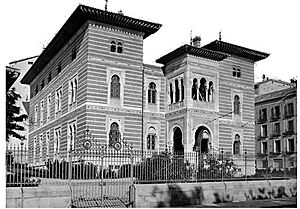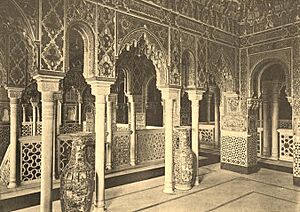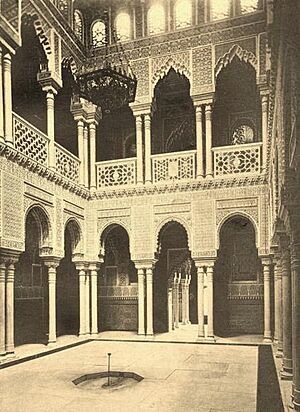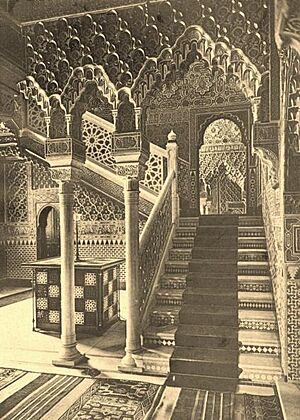Palacio de Xifré facts for kids
The Palacio de Xifré was a grand palace in Madrid, Spain. It used to stand on the Paseo del Prado, right across from the famous Prado Museum. This palace was a fantastic example of Neo-Mudéjar architecture. This style brought back old Spanish-Islamic designs.
The Palacio de Xifré was one of many beautiful homes built by rich Spanish families in the late 1800s. These families built their palaces along important streets like the Paseo del Prado. Sadly, this amazing building is no longer standing today.
Contents
History of the Xifré Palace
In the 1800s, a special area in Madrid was known as the "Bankers' Quarter." This area was around the Paseo del Prado and Paseo de Recoletos. It was where the wealthiest families of Madrid chose to live.
Building the Palace
The Palacio de Xifré was built in this fancy neighborhood. It was located on the Paseo del Prado, at the corner of Calle Lope de Vega. A wealthy businessman named Josep Xifré Downing had it built. Construction took place between 1862 and 1865.
Josep Xifré Downing inherited a huge fortune from his father, Josep Xifré i Casas. His father had many businesses in places like Cuba, the US, and Europe. Josep Xifré Downing wanted a unique palace.
Inspired by the Alhambra
He met an architect named José Contreras. Contreras was an expert in restoring the Alhambra in Granada. The Alhambra is a famous palace known for its beautiful Islamic art. Xifré Downing gave Contreras a scholarship to study the Alhambra's designs. He wanted these designs to be used in his new palace.
In 1857, Xifré Downing bought nine plots of land for his palace. These plots were from the Duke of Medinaceli. The construction work on the palace began in 1858 and finished in 1862.
A Sumptuous Design
The Palacio de Xifré was one of the best examples of Neo-Mudéjar architecture in Madrid. Many people thought it was one of the most luxurious buildings in the city. From its outer gate to its inner rooms, it perfectly copied the style of ancient al-Andalusian architecture. This was a golden age for art and building in Spain.
Later Owners
After Josep Xifré Downing passed away, his son, Josep Xifré Hamel, inherited the palace. In 1914, Hamel sold the building. The palace then became the official home for the Mexican Ambassador, Manuel de Iturbe.
Over time, the palace was not well cared for. Later, the Duke of the Infantado bought it to live in. The Duke of the Infantado is a very old and important title in Spain. It was first given in 1475.
The Palace is Demolished
In 1949, a real estate company bought the palace. Sadly, they tore it down just one year later, in 1950. A new building was built in its place. This new building is now the Ministry of Health.
Remains of the Palace
Even though the palace was torn down, some parts of it were saved. They were moved to different places:
- The main facade was bought by Arturo Ruiz Piña. He used it for a hotel in a village called Losa de Riofrío.
- The beautiful staircase from the palace went to the town of Chiloeches.
- The Embassy of France bought the palace's fancy hardwood floors.
- The Marquises of Deleitosa bought some eaves and decorations. They used them on their farm in Salamanca.
- The central courtyard, with its marble columns, was bought by José Soto Huerta. He put it on his farm near Barajas.
- The Directorate General of Architecture bought some windows. They were meant for the School of Architecture. However, most of them were taken, and the remaining large pieces are now very damaged.
Images for kids
See also
 In Spanish: Palacio de Xifré para niños
In Spanish: Palacio de Xifré para niños









